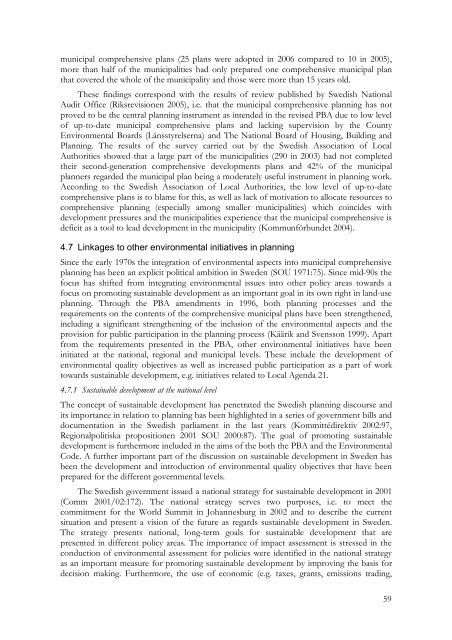SEA IN THE CONTEXT OF LANDTUSE PLANNING
SEA IN THE CONTEXT OF LANDTUSE PLANNING
SEA IN THE CONTEXT OF LANDTUSE PLANNING
Create successful ePaper yourself
Turn your PDF publications into a flip-book with our unique Google optimized e-Paper software.
municipal comprehensive plans (25 plans were adopted in 2006 compared to 10 in 2005),more than half of the municipalities had only prepared one comprehensive municipal planthat covered the whole of the municipality and those were more than 15 years old.These findings correspond with the results of review published by Swedish NationalAudit Office (Riksrevisionen 2005), i.e. that the municipal comprehensive planning has notproved to be the central planning instrument as intended in the revised PBA due to low levelof up-to-date municipal comprehensive plans and lacking supervision by the CountyEnvironmental Boards (Länsstyrelserna) and The National Board of Housing, Building andPlanning. The results of the survey carried out by the Swedish Association of LocalAuthorities showed that a large part of the municipalities (290 in 2003) had not completedtheir second-generation comprehensive developments plans and 42% of the municipalplanners regarded the municipal plan being a moderately useful instrument in planning work.According to the Swedish Association of Local Authorities, the low level of up-to-datecomprehensive plans is to blame for this, as well as lack of motivation to allocate resources tocomprehensive planning (especially among smaller municipalities) which coincides withdevelopment pressures and the municipalities experience that the municipal comprehensive isdeficit as a tool to lead development in the municipality (Kommunförbundet 2004).4.7 Linkages to other environmental initiatives in planningSince the early 1970s the integration of environmental aspects into municipal comprehensiveplanning has been an explicit political ambition in Sweden (SOU 1971:75). Since mid-90s thefocus has shifted from integrating environmental issues into other policy areas towards afocus on promoting sustainable development as an important goal in its own right in land-useplanning. Through the PBA amendments in 1996, both planning processes and therequirements on the contents of the comprehensive municipal plans have been strengthened,including a significant strengthening of the inclusion of the environmental aspects and theprovision for public participation in the planning process (Käärik and Svensson 1999). Apartfrom the requirements presented in the PBA, other environmental initiatives have beeninitiated at the national, regional and municipal levels. These include the development ofenvironmental quality objectives as well as increased public participation as a part of worktowards sustainable development, e.g. initiatives related to Local Agenda 21.4.7.1 Sustainable development at the national levelThe concept of sustainable development has penetrated the Swedish planning discourse andits importance in relation to planning has been highlighted in a series of government bills anddocumentation in the Swedish parliament in the last years (Kommittédirektiv 2002:97,Regionalpolitiska propositionen 2001 SOU 2000:87). The goal of promoting sustainabledevelopment is furthermore included in the aims of the both the PBA and the EnvironmentalCode. A further important part of the discussion on sustainable development in Sweden hasbeen the development and introduction of environmental quality objectives that have beenprepared for the different governmental levels.The Swedish government issued a national strategy for sustainable development in 2001(Comm 2001/02:172). The national strategy serves two purposes, i.e. to meet thecommitment for the World Summit in Johannesburg in 2002 and to describe the currentsituation and present a vision of the future as regards sustainable development in Sweden.The strategy presents national, long-term goals for sustainable development that arepresented in different policy areas. The importance of impact assessment is stressed in theconduction of environmental assessment for policies were identified in the national strategyas an important measure for promoting sustainable development by improving the basis fordecision making. Furthermore, the use of economic (e.g. taxes, grants, emissions trading,59
















